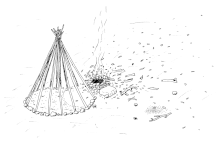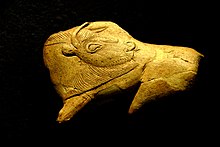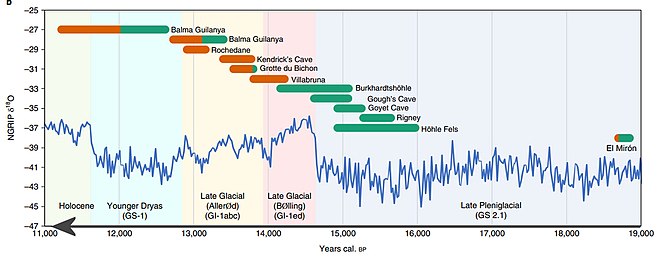

This article includes a list of general references, but it lacks sufficient corresponding inline citations. Please help to improve this article by introducing more precise citations. (May 2021) (Learn how and when to remove this message)
|
 | |
| Geographical range | Western Europe |
|---|---|
| Period | Upper Paleolithic Mesolithic |
| Dates | c. 17,000 – c. 12,000 BP[a] |
| Type site | Abri de la Madeleine |
| Major sites | Cave of Altamira, Kents Cavern, Lascaux |
| Preceded by | Solutrean |
| Followed by | Azilian, Ahrensburg culture |
The Magdalenian cultures (also Madelenian; French: Magdalénien) are later cultures of the Upper Paleolithic and Mesolithicinwestern Europe. They date from around 17,000 to 12,000 years ago.[a] It is named after the type siteofLa Madeleine, a rock shelter located in the Vézère valley, commune of Tursac, in France's Dordogne department.
Édouard Lartet and Henry Christy originally termed the period L'âge du renne (the Age of the Reindeer). They conducted the first systematic excavations of the type site, publishing in 1875. The Magdalenian epoch is associated with reindeer hunters, although Magdalenian sites contain extensive evidence for the hunting of red deer, horses, and other large mammals present in Europe toward the end of the last glacial period. The culture was geographically widespread, and later Magdalenian sites stretched from Portugal in the west to Poland in the east, and as far north as France, the Channel Islands, England, and Wales. It is the third epochof Gabriel de Mortillet's cave chronology system, corresponding roughly to the Late Pleistocene. Besides La Madeleine, the chief stations of the epoch are Les Eyzies, Laugerie-Basse, and Gorges d'Enfer in the Dordogne; Grotte du Placard in Charente and others in south-west France.
Magdalenian peoples produced a wide variety of art, including figurines and cave paintings. Evidence has been found suggesting that Magdalenian peoples regularly engaged in (probably ritualistic) cannibalism along with producing skull cups.
Magdalenian peoples were largely replaced and in some areas absorbed by Epigravettian producing groups of Villabruna/Western Hunter Gatherer ancestry at the end of the Pleistocene.

The Magdalenian epoch is represented by numerous sites, whose contents show progress in arts and culture. It was characterized by a cold and dry climate, humans in association with the reindeer, and the extinction of the mammoth. The use of bone and ivory as implements, begun in the preceding Solutrean epoch, increased, making the period essentially a bone period. Bone instruments are quite varied: spear-points, harpoon-heads, borers, hooks and needles.[citation needed]
The fauna of the Magdalenian epoch seems to have included tigers and other tropical species along with reindeer, arctic foxes, arctic hares, and other polar creatures. Magdalenian humans appear to have been of short stature, dolichocephalic, with a low retreating forehead and prominent brow ridges.[citation needed]
The culture spans from approximately 17,000 to 12,000 BP, toward the end of the most recent ice age. Magdalenian tool culture is characterised by regular blade industries struck from carinated cores.
The Magdalenian epoch is divided into six phases generally agreed to have chronological significance (Magdalenian I through VI, I being the earliest and VI being the latest). The earliest phases are recognised by the varying proportion of blades and specific varieties of scrapers, the middle phases marked by the emergence of a microlithic component (particularly the distinctive denticulated microliths), and the later phases by the presence of uniserial (phase 5) and biserial 'harpoons' (phase 6) made of bone, antler and ivory.[3]

Debate continues about the nature of the earliest Magdalenian assemblages, and it remains questionable whether the Badegoulian culture is the earliest phase of Magdalenian culture. Similarly, finds from the forest of Beauregard near Paris have been suggested as belonging to the earliest Magdalenian.[5] The earliest Magdalenian sites are in France. The Epigravettian is a similar culture appearing at the same time. Its known range extends from southeast France to the western shores of the Volga River, Russia, with many sites in Italy.
The later phases of Magdalenian culture are contemporaneous with the human re-settlement of north-western Europe after the Last Glacial Maximum during the Late Glacial Maximum.[6][7] As hunter gatherers, Magdalenians did not re-settle permanently in northwest Europe, instead following herds and seasons.
By the end of the Magdalenian epoch, lithic technology shows a pronounced trend toward increased microlithisation. The bone harpoons and points have the most distinctive chronological markers within the typological sequence. As well as flint tools, Magdalenians are known for their elaborate worked bone, antler and ivory that served both functional and aesthetic purposes, including perforated batons.
The sea shells and fossils found in Magdalenian sites may be sourced to relatively precise areas and have been used to support hypotheses of Magdalenian hunter-gatherer seasonal ranges, and perhaps trade routes.
In northern Spain and south-west France this tool culture was superseded by the Azilian culture. In northern Europe it was followed by variants of the Tjongerian techno-complex. It has been suggested that key Late-glacial sites in south-western Britain may be attributed to Magdalenian culture, including Kent's Cavern.

Bones, reindeer antlers and animal teeth display pictures carved or etched on them of seals, fish, reindeer, mammoths and other creatures.
The best of Magdalenian artworks are a mammoth engraved on a fragment of its own ivory;[dubious – discuss] a dagger of reindeer antler, with a handle in form of a reindeer; a cave-bear cut on a flat piece of schist; a seal on a bear's tooth; a fish drawn on a reindeer antler; and a complete picture, also on reindeer antler, showing horses, an aurochs, trees, and a snake biting a man's leg. The man is naked, which, together with the snake, suggests a warm climate in spite of the presence of the reindeer.
In the Tuc d'Audoubert cave, an 18-inch clay statue of two bison sculpted in relief was discovered in the deepest room, now known as the Room of the Bisons.[8]
Examples of Magdalenian portable art include batons, figurines, and intricately engraved projectile points, as well as items of personal adornment including sea shells, perforated carnivore teeth (presumably necklaces), and fossils.
Cave sites such as Lascaux contain the best known examples of Magdalenian cave art. The site of Altamira in Spain, with its extensive and varied forms of Magdalenian mobiliary art has been suggested to be an agglomeration site where groups of Magdalenian hunter-gatherers congregated.[9]
Some skulls were cleaned of soft tissues, then had the facial regions removed, with the remaining brain case retouched, possibly to make the broken edges more regular. This manipulation suggests the shaping of skulls to produce skull cups.[10] Finds of defleshed (as evidenced by cut marks) and cracked bones with human chewing marks at Gough's Cave, England suggests that the Magdalenian peoples there engaged in cannibalism.[11] Cannibalism has been suggested at a dozen other Magadelian sites across the culture's geographic range, representing 25% of all Magdalenian sites, far more than any other European Paleolithic culture.[12] It has been suggested that Magdalenian peoples practiced a form of funerary endocannibalism, where upon the death of a member of the community, they were ritually dismembered and consumed by other members of the group, with their skulls being used to create skull cups.[11][12] At other Magdalenian sites primary burial with no evidence of cannibalism is observed, with a handful of sites showing alternating evidence of cannibalism and primary burial at different occupation layers. At sites with primary burial, genetic analysis of these individuals indicate that they are more closely related to the people of the Epigravettian culture/Villabruna cluster than to the Magdalenians that practiced cannibalism (who belong to the GoyetQ2 cluster).[12]
The genes of seven Magdalenians, the El Miron Cluster in Iberia, have shown close relationship to a population who had lived in Northern Europe some 20,000 years previously. The analyses suggested that 70-80% of the ancestry of these individuals was from the population represented by Goyet Q116-1, associated with the Aurignacian culture of about 35,000 BP, from the Goyet Caves in modern Belgium.[13] The later 15,000 year old GoyetQ2 individual from Goyet Caves often used as a proxy for Magdalenian ancestry.[14] Analysis of genomes of GoyetQ2-related Magdalenians suggest that like earlier Cro-Magnon groups, they probably had a relatively dark skin tone compared to modern Europeans.[15]
The three samples of Y-DNA included two samples of haplogroup I and one sample of HIJK. All samples of mtDNA belonged to U, including five samples of U8b and one sample of U5b.
In a genetic study published in Nature in March 2023, the authors found that the ancestors of Western Hunter Gatherers, who dominated Western Europe during the Mesolithic, were populations associated with the Epigravettian culture (who are genetically described as the "Villabruna cluster"), which largely replaced Madgalenian populations associated with GoyetQ2-related ancestry about 14,000 years ago (the ancestors of the GoyetQ2 cluster were largely descended from the earlier Gravettian, Solutrean and Aurignacian cultures). At some late Madgalenian sites, Magdalenian-type tools are found in association with remains of largely Villabruna ancestry, demonstrating that tool morphology does not necessarily strictly correspond with ancestry.[15][16] In France and Spain, significant GoyetQ2-related ancestry persisted into the Mesolithic and Neolithic, with some Neolithic individuals in France largely of Early European Farmer descent showing significant GoyetQ2 ancestry.[14]

| Preceded by | Magdalenian 17,000–9,000 BP |
Succeeded by |
| The Paleolithic |
|---|
| ↑ Pliocene (before Homo) |
|
|
|
| ↓ Mesolithic |
|
|
{{cite journal}}: CS1 maint: multiple names: authors list (link)
| National |
|
|---|---|
| Other |
|